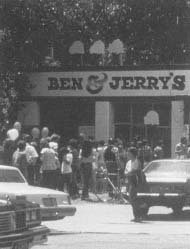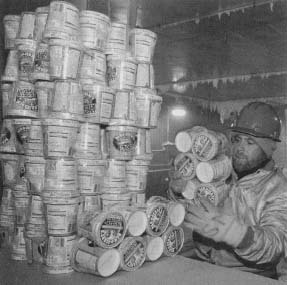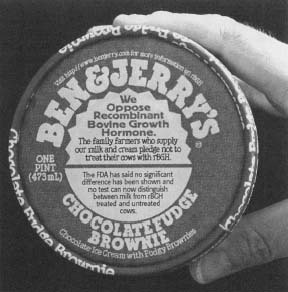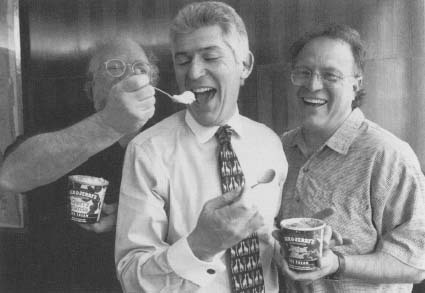Ben & Jerry's
Homemade, Inc.
30 Community Drive
South Burlington, VT 05403-6828
(802) 846-1500
www.benandlerrys.com

Ben Cohen and Jerry Greenfield are best friends as well as founders of Ben & Jerry's Homemade Inc., makers of super premium ice cream, frozen yogurt, and sorbet. In 1978, the pair opened their first ice cream parlor in a renovated gas station in rural Burlington, Vermont. Their ice cream, which was made from high-quality ingredients, including milk and cream from local dairy farmers, soon caught the attention of ice cream buyers across the United States. In 1981, Time named Ben & Jerry's ice cream the best in the world.
Today, the company sells its frozen concoctions in more than one hundred and thirty scoop shops in all fifty states. Ben & Jerry's can also be found in Canada, Great Britain, France, the Netherlands, and Israel. The company, however, does more than just sell ice cream. Cohen and Greenfield started a revolution in the food business when they decided to give a percentage of company profits to charitable organizations, usually associated with social causes and the environment. When the company was acquired by Unilever in 1999, many people accused Cohen and Greenfield of "selling out" their ideals to big business.
Junior High Friends
Ben Cohen and Jerry Greenfield met in 1963 in their seventh grade gym class in suburban Merrick, New York. Their common bond was a love of ice cream and a hatred of running laps in gym class. This common love of ice cream would follow them throughout their lives. Cohen's first "taste" of the business came in his senior year of high school, when he drove a truck selling ice cream to neighborhood children. Both men graduated from Calhoun High School in 1969 and went off to separate colleges. Cohen dropped out before graduating, while Greenfield graduated from Oberlin College in Ohio. He worked in the college cafeteria selling ice cream.
By 1976, both men were living in upstate New York, where Cohen was experimenting with ice cream making. In 1977, the two friends decided to start their own ice cream business, although neither knew anything about such a venture. To get up to speed, they signed up for a $5 correspondence course from Pennsylvania State University in ice cream making; they both got A's. During this time, the two had great fun making up peculiar flavors of ice cream, even though some of their trials flopped. "I once made a batch of rum raisin that stretched and bounced," Greenfield told People magazine.
Ben & Jerry's at a Glance
- Employees: 850
- CEO: Yves Couette
- Subsidiaries: None; Ben & Jerry's is a subsidiary of Unilever
- Major Competitors: Nestle; Häagen-Dazs; Dreyer's
- Notable Products: Chocolate Fudge Brownie frozen yogurt; Peanut Butter Cup ice cream; Chunky Monkey ice cream; Cherry Garcia frozen yogurt; Half Baked 2-Twisted ice cream; New York Super Fudge Chunk ice cream; Phish Food ice cream; Chocolate Fudge Brownie ice cream; Chocolate Chip Cookie Dough ice cream; Cherry Garcia ice cream
Scoop Shop Opens
In 1978, Cohen and Greenfield used $8,000 of their own money and $4,000 that they borrowed to open their first Ben & Jerry's ice cream shop in Burlington, Vermont. The store opened on May 5 in a renovated gas station at the corner of St. Paul and College streets in downtown Burlington. To help attract business, the men held a summer film festival, projecting movies on the outside wall of the shop. Greenfield made all the ice cream, inventing such bizarre flavors as Dastardly Mash, Chunky Monkey (with bananas), and Tuskegee Chunk (with peanut butter).
Timeline
- 1978:
- Ben Cohen and Jerry Greenfield start Ben & Jerry's Homemade Inc. and open their first ice cream scoop shop in Burlington, Vermont.
- 1979:
- In what becomes a yearly event, Ben & Jerry's celebrates its first anniversary by giving away free ice cream cones.
- 1980:
- The company begins distributing ice cream to grocery stores and restaurants in the Burlington, Vermont, area.
- 1981:
- The company opens a pint-packing plant in South Burlington, Vermont.
- 1982:
- Greenfield retires from Ben & Jerry's.
- 1983:
- The first out-of-state franchise scoop shop opens in Portland, Maine.
- 1985:
- The Ben & Jerry's Foundation is established.
- 1987:
- Ben & Jerry's introduces its popular Cherry Garcia ice cream flavor.
- 1990:
- Annual profits are $77 million, a 32 percent increase over 1989.
- 1992:
- The company opens a scoop shop and manufacturing plant in Russia.
- 1995:
- Robert Holland becomes CEO.
- 1997:
- The company introduces a line of low-fat ice cream.
- 1999:
- Ben & Jerry's has net annual sales of $237 million, a 13.3 increase over 1998.
- 2000:
- The British-Dutch conglomerate Unilever buys Ben & Jerry's for $236 million.
- 2002:
- Unilever announces plans to greatly expand Ben & Jerry's presence in Europe.
The dense, rich ice cream was a hit, and the two friends who met in junior high had a successful business on their hands. While they still loved ice cream, neither man enjoyed the nuts and bolts of running a business, so they hired a local nightclub operator, Fred "Chico" Lager, to handle their finances. As sales continued to increase, the company celebrated its one-year anniversary in 1979. To celebrate, Ben & Jerry's gave out free scoops of ice cream all day. The promotion has become an annual even at Ben & Jerry's scoop shops nationwide.
Company Expands
In 1980, Cohen and Greenfield rented space in an old spool and bobbin mill in Burlington, where they began packing their ice cream in pint containers. They started selling the pints to small grocery stores and restaurants, which Cohen distributed from his old Volkswagen square-back station wagon. The pints of ice cream were a big hit and within a year, Cohen and Greenfield had to move the pint-packaging operation to a larger facility in South Burlington. In 1981, the first Ben & Jerry's franchise scoop shop opened in Shelburne, Vermont. This means that someone besides Ben and Jerry owned and operated the shop, but they were educated by the original owners in retailing and told what to sell and how much to charge.
During the first three years of scoop shop operation, Ben & Jerry's ice cream attained a kind of cult status in New England. Part of it was because the company used such high-quality ingredients to make an exquisitely rich product. Another reason, however, was that Cohen and Greenfield consistently come up with some pretty imaginative flavors and names for their ice cream. One flavor that was particularly popular was called Cherry Garcia in honor of Jerry Garcia (1942-1995), lead singer of the Grateful Dead.
The company continued to grow and in 1982, the original Ben & Jerry's scoop shop was demolished to make way for a parking lot. A new shop opened at the corner of Cherry Street and South Winooski Avenue in Burlington. The following year, the company expanded outside of Vermont, opening a franchise scoop shop in Portland, Maine. Ben & Jerry's also began to sell pints in Boston, Massachusetts, through independent ice cream distributors.
Business Pressures Mount
As the company soared beyond anything Cohen and Greenfield could possibly have imagined, both men began to experience the pressures of running a fast-growing business. Success also brought the two childhood friends incredible wealth. Suddenly, the pair of former hippies found themselves part of the corporate establishment, a position they both felt uncomfortable in.
Greenfield "retired" and moved to Arizona in 1982, and Cohen contemplated selling the business. "I had this horrible feeling come over me that I had become a businessman. Worse, that now I was just some kind of mindless cog in the overall economy," he told Inc. in 1988. Instead of putting the company up for sale, Cohen told People, they "decided to adapt it so we could feel proud to say we were the businessmen of Ben & Jerry's." So with Greenfield leaving most of the business operations and decisions to Cohen, the company adopted a philosophy that was unique in the world of high finance: it would maintain its goal of being profitable, but it would also demonstrate a commitment to social change and environmental responsibility
Nonprofit Foundation Launched
In 1984, Ben & Jerry's expanded its South Burlington packing plant. The Ben & Jerry's Foundation was established one year later, and Greenfield returned from Arizona to run it. Through the foundation the company donates 7.5 percent of its pre-tax income to nonprofit social and environmental programs. That same year, Ben & Jerry's had a setback when the company sued Pillsbury's Häagen-Dazs division for threatening to cut off suppliers who bought Ben & Jerry's products. The suit was settled out of court.
Cows on the Move
Ben & Jerry's is known for its whimsical advertising stunts. In 1986, the company launched the "Cowmobile," a mobile home that Cohen and Greenfield planned to drive across the country and distribute free scoops of ice cream. Unfortunately, the Cowmobile caught fire and burned just four months into the trip. No one was injured, but the expedition was cancelled. In 1987, Cohen and Greenfield revisited their plan and "Cow II" was born. When the stock market crashed in October 1987, Cow II appeared on Wall Street to hand out free scoops of "That's Life" and "Economic Crunch" ice cream.
In 1988, the company hired a management consultant, who helped the duo define their mission. In the company's 1989 annual report, Cohen reflected a new sense of purpose,

Staying "Weird" But Still Growing
Still, could two ex-hippies keep the "weird" in Ben & Jerry's, no matter how big it was getting? "The idea, I think, is to maintain the values of your culture and yet bring it along with you," Greenfield told Inc. "I mean, you don't want to stay stuck in the past. I think our company will be changed. I think there's no doubt about that. We just have to make it a good change."

By 1990, Ben & Jerry's total sales were $77 million, a 32 percent increase over 1989. Although now officially part of "corporate America," Cohen and Greenfield insisted that the socially conscious arm of the company's mission extend to its own employees. In 1990, the company opened a day-care center next to its Waterbury, Vermont, plant. The same year, it began a policy of paid time off for employees who adopt a child. One benefit that has been somewhat controversial is offering health insurance for gay partners of employees and for unmarried partners of employees.
In 1992, the company opened a scoop shop and manufacturing facility in Russia. It began looking for a new chief executive office (CEO) in 1994, conducting a two-pronged search, which included holding a "Yo! I'm Your CEO" contest. Entrants applied by submitting 100-word essays on why they deserved to be CEO. The company also hired a search firm to look for a new CEO. In 1995, Ben & Jerry's named Robert Holland to the position. He was found by the search firm rather than through the contest. Holland resigned as CEO in 1996.
Unilever Devours Ben & Jerry's
The date April 12, 2000, marked a turning point in the story of Ben & Jerry's. The company's board of directors sold the company with a conscious to Unilever, a giant British-Dutch consumer product conglomerate, for $326 million. A conglomerate is a group made up of a number of different companies. In this case, Unilever and its subsidiaries make a variety of consumer products, such as Dove soap, Lipton teas, and Skippy peanut butter.
Always Room for Change
At Ben & Jerry's Web site, the focus is just as much on social change as it is on ice cream. You can learn about special flavors made from special sources, including Rainforest Crunch (a discontinued flavor), which used nuts produced by rain forest trees, or Chocolate Fudge Brownie, made with chunks of brownies from a bakery in New York where formerly unemployed and homeless people work.
The company also hosts events and actively targets specific causes. In 2002, it partnered with the Dave Matthews Band (DMB) and a coalition of environmental organizations to form "One Sweet Whirled," a campaign to fight global warming. Global warming is a result of damage to the ozone layer, which surrounds the earth and protects it from the ultraviolet rays of the sun. The One Sweet Whirled ice cream flavor was launched in the spring, with proceeds from every sale going to DMB Bama Works Foundation.
Ben & Jerry's also pledged to take a close look at itself. Chemicals produced by industry are largely responsible for harming the ozone layer. A particular threat is carbon dioxide. The company has made a commitment to reduce its carbon dioxide emissions by 10 percent from 2002 to 2007. To do so, it will take several steps, which include looking into alternative forms of energy and educating employees on how to efficiently use energy.
After the merger, many people, including some of Ben & Jerry's most loyal customers, felt that Cohen and Greenfield had sold out to corporate America. In addition, the company's reputation for doing social and environmental good became

To announce the sale, Cohen and Greenfield released a joint statement: "Neither of us could have anticipated twenty years ago that a major multinational would some day sign on, enthusiastically, to pursue and expand the social mission that continues to be an essential part of Ben & Jerry's and a driving force behind our many successes. While we and others certainly would have preferred to pursue our mission as an independent enterprise, we hope that, as part of Unilever, Ben & Jerry's will continue to expand its role in society."
Unilever Replaces CEO
A few months after the sale, Unilever replaced Ben & Jerry's CEO Perry Odak with longtime Unilever executive Yves Couette. Cohen and Greenfield, who still sat on Ben & Jerry's board of directors expressed disappointment at the change and said they would reevaluate their role with the company. Unilever's main goals are to make the ice cream brand more globally recognized while maintaining Ben & Jerry's environmental and social commitments.
Many people think that Ben & Jerry's is a great place to work, and it is consistently listed as one of the best places to work in the United States. The company is noted for treating its employees to such perks as free ice cream, massages at work, and frequent company outings and events. Traditions include Elvis Presley day and an annual Halloween costume celebration.
"To preserve the brand, we need to make sure we still do things that are Ben-and-Jerry like," Couette said in a 2002 interview with Food Processing. He also said Unilever plans to increase the number of Ben & Jerry's scoop shops in the United States from 250 to 1,000. In 2002, Unilever announced plans to greatly expand Ben & Jerry's presence in Europe, including opening seventy-five scoop shops in Spain over the next four or five years.
Comment about this article, ask questions, or add new information about this topic: